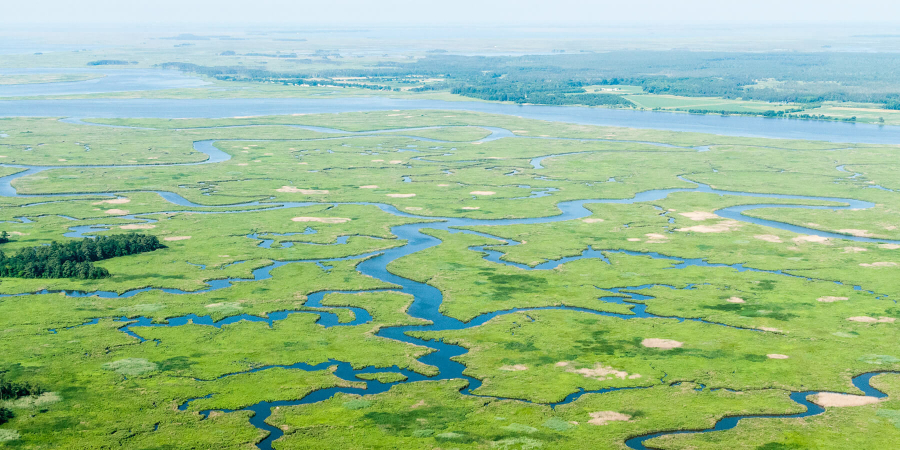Watershed Implementation Plans
Watershed Implementation Plans (WIPs) include detailed, specific steps each jurisdiction will take to meet the goals of the Chesapeake Bay Total Maximum Daily Load by 2025.

Watershed Implementation Plans (WIPs) include detailed, specific steps each of the seven Bay watershed jurisdictions will take to meet the pollution reduction goals of the Chesapeake Bay Total Maximum Daily Load (TMDL) by 2025. These plans consider such things as ecological restoration and sustainability while allowing for greater transparency and accountability for improved performance.
What are WIPs?
The Chesapeake Bay TMDL requires reductions of nitrogen, phosphorus and sediment. This federal effort is intended to obtain water quality standards for each of the Bay’s tidal segments, tributaries and embayments listed as impaired under 303(d) of the Clean Water Act. Each watershed jurisdiction has created a Watershed Implementation Plan, often called a WIP, that documents how the jurisdiction will partner with federal and local governments to achieve and maintain water quality standards.
There are three phases of WIPs:
- Phase I and Phase II WIPs were developed and submitted to EPA in 2010 and 2012, respectively. Both Phase I and Phase II WIPs describe actions and controls to be implemented by 2017 and 2025 to achieve applicable water quality standards.
- Phase III WIPs will be developed by jurisdictions based on a midpoint assessment of progress and scientific analyses that is currently underway through 2017. Phase III WIPs will provide information on actions the Bay jurisdictions intend to implement between 2019 and 2025 to meet the Bay restoration goals.
Learn more in this fact sheet about the Phase III WIPs.
Key Documents and Tools
- Phase III WIP final planning targets
- Environmental Protection Agency's Phase III WIP expectations letter and fact sheet
- Stakeholder assessment identifying lessons learned from the Phase I and II WIP processes: final report and action plan
Explaining Nutrient and Sediment Loads
- A History of Nutrient and Sediment Inputs to Chesapeake Bay, 1985-2016
- Nutrient Loads and Trends in Chesapeake Bay Nontidal Network Streams
- Dissecting Drivers of Nutrient Trends in Chesapeake Bay Streams
- Chesapeake Sediment Synthesis: Sediment sources, transport, delivery and impacts in the Chesapeake Bay watershed
- Presentation: Understanding the Influence of the Conowingo Reservoir Infill on Expectations for States’ Nutrient and Sediment Pollutant Load Reductions
- Webinar: Understanding the Influence of the Conowingo Reservoir Infill on Expectations for States’ Nutrient and Sediment Pollutant Load Reductions
Best Management Practice Tools
- Chesapeake Assessment and Scenario Tool (CAST): CAST is an online version of the Chesapeake Bay Program's Phase 6 Wastershed Model. Using CAST, helps local planners can better understand which best management practices (BMPs) can provide the greatest reduction in nitrogen, phosphorus and sediment loads, how much various implementation options might cost, and indicate which practices would be most successful given a geographic area.
- Quick Reference Guide for Best Management Practices: This guide provides summarized profiles for each CBP-approved BMP in the Watershed Model. Each reference sheet includes basic general information about a BMP, how it functions within the model, what’s needed for the BMP to be reported for annual progress submissions, as well as links to additional information for readers who want more detailed information about the practice.
- BMP co-benefit presentation: This presentation is designed to inform WIP developers, local governments and other stakeholders about the co-benefits associated with implementing certain conservation practices. The majority of these practices not only help in meeting your state’s water quality goals under the TMDL, but also can meet other restoration goals not only for the Chesapeake Bay, but for the local waterways in your community.
- BMP co-benefit fact sheets: The following set of 12 fact sheets describe the co-benefits that are possible when best management practices are selected in a thoughtful manner with site-specific conditions in mind. Each includes contact information for each state for more information.
Local Engagement
Learn how the jurisdictions are working to develop local planning goals and incorporate public input in their Phase III WIPs: Delaware | District of Columbia | Maryland | New York | Pennsylvania | Virginia | West Virginia
Watershed Implementation Plans
- Delaware - Phase I | Phase II | Phase III
- District of Columbia - Phase I | Phase II | Phase III
- Maryland - Phase I | Phase II | Phase III
- New York - Phase I | Phase II | Phase III
- Pennsylvania - Phase I | Phase II | Phase III
- Virginia - Phase I | Phase II | Phase III
- West Virginia - Phase I | Phase II | Phase III
Read EPA's evaluations of the Phase III WIPs.
Contacts
To get involved in the process of developing or instating WIPs, or get answers to state-specific questions, please visit your state's website or contact your WIP lead.
- Delaware - Steve Williams, DNREC - (302) 729-9921
- District of Columbia - Steve Saari, DOEE - (202) 997-9607
- Maryland - Dinorah Dalmasy, MDE - (410) 537-3818
- New York - Cassandra Davis, DEC - (518) 402-8152
- Pennsylvania - Jill Whitcomb, DEP - (717) 783-5205
- Virginia - Megan Sommers-Bascone, DEQ - (804) 659-1381
- West Virginia - Samuel Canfield - (681) 319-6306
